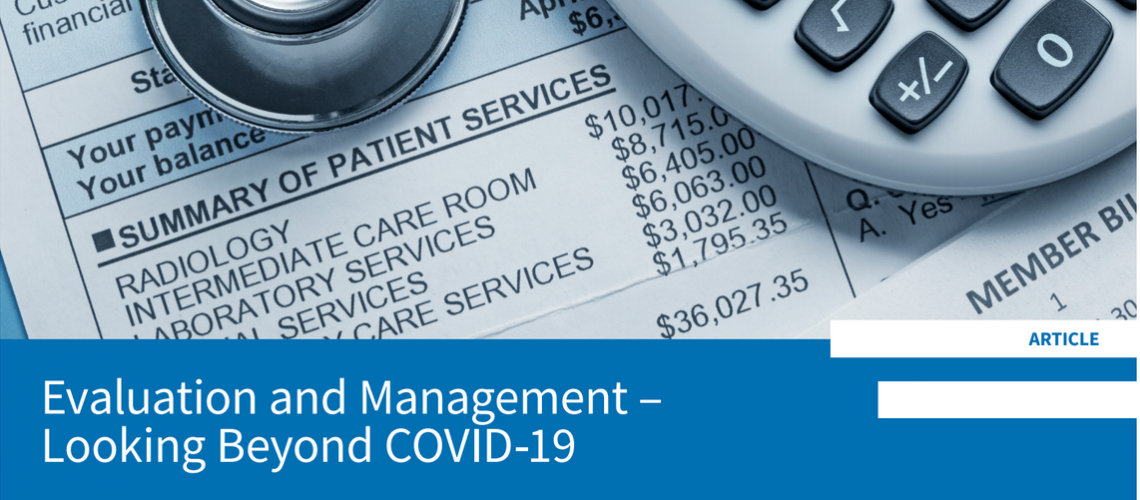Now that the initial wave of Covid-19 has passed and providers have mastered the telehealth billing requirements, it is time to turn attention to the 2021 Evaluation and Management (E&M) changes and their impact on a provider’s practice. Much of what was learned during the Public Health Emergency (PHE) will aid physicians as they transition to the “new” E&M requirements. However, there are still significant changes on the horizon that require attention for a practice to function efficiently and compliantly.
The 2021 E&M changes apply only to the office and outpatient (99201-99215) series of codes.1 The changes incorporate moving to a code assignment based on either time or medical decision-making (MDM). Sound familiar? This concept was introduced for use with telehealth during the Public Health Emergency (PHE) using the time increments provided in the Current Procedural Terminology (CPT) and the existing model of medical decision-making found in the 1995 E&M Guidelines. The 2021 E&M changes utilize new (longer) total time increments and a new matrix/methodology for MDM.2The 2021 guidance is a work in progress, but some of the published highlights are as follows:
—The new guidance applies only to the 99202-99215 series of codes utilized in the physician office or in outpatient clinic settings. Physicians practicing in multiple locations will need to be cognizant that the requirements differ from site to site.
—Code 99201 (office or outpatient visit requiring a problem-focused history and physical with straightforward medical decision-making) is being deleted.
—Code selection will be based upon either time or medical decision-making. No longer does the amount of history/physical examination documented affect the level of service. However, a medically appropriate and/or necessary history and exam are required, which is determined by provider.
—For the office/outpatient series of codes (99202-99215), the definition of time is no longer tied to the amount of counseling or coordinating care performed but rather is defined as the total time the physician or qualified health professional spent on the day of the encounter. This is inclusive of all face-to-face time AND non-face-to face time spent by the physician or qualified health care professional. It does NOT include time spent by other clinical staff. The time must be documented by the provider.
—If the patient is seen by both a physician AND a qualified healthcare professional, the time is summed to obtain total time. However, if the physician and qualified healthcare professional jointly see the patient, the time can be counted only once.
—The general rules around medical decision-making are similar to previous years, but the components of MDM have been more clearly defined and are perhaps more restrictive.
—The time increments associated with each code have been expanded. For example, a 99214 has been expanded to 47 minutes total time, from 25 minutes face-to-face time.
—There will be new codes for prolonged services. The above changes are significant and require attention prior to January 2021. While education is critical for compliance, it is not the sole component. Organizations need to develop and initiate a planning process to determine the processes and workflows that might be impacted by these changes, as well as the estimated financial impact.
Though processes vary among practices, all should assess the following areas:
✓Physician education
✓Coder education
✓Modification to EHR templates
✓Modification to charge tickets or documentation tools
✓Changes to policies and procedures
✓Internal monitoring procedures for financial and compliance monitoring
Much remains unknown because of the ongoing public health emergency. How long will it last? What components of the PHE waivers will survive? Will implementation of the 2021 E&M changes be delayed due to the PHE? As of the writing of this article, no delay has been proposed. Will differing standards be used for coding telehealth versus office visits? If recent history is any indication, there will be efforts made to simplify.
However, regardless of whether the existing criteria for code assignment (CPT time and current MDM grid) remain unchanged, or whether the 2021 changes (new total time increments and new MDM grid) or some combination of the two is implemented, the potential for a shift in code assignment and resulting compliance risk is real.
Do not delay in beginning the assessment process. Identify a project manager who will develop a plan to address all the items above, and empower them to build a team that is able to drive the transition in a timely manner.
——————————————————
Photo courtesy of: JD Supra
Originally Published On: JD Supra
Follow Medical Coding Pro on Twitter: www.Twitter.com/CodingPro1
Like Us On Facebook: www.Facebook.com/MedicalCodingPro







